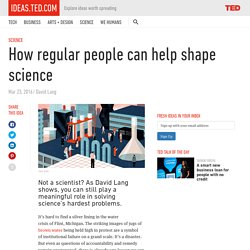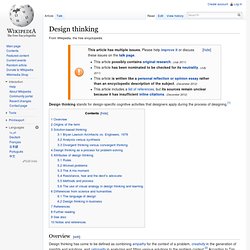

How regular people can help shape science. Jun Cen It’s hard to find a silver lining in the water crisis of Flint, Michigan.

The striking images of jugs of brown water being held high in protest are a symbol of institutional failure on a grand scale. It’s a disaster. But even as questions of accountability and remedy remain unanswered, there is already one lesson we can take away: Citizen science can be used as a powerful tool to build (or rebuild) the public’s trust in science.
Because the other striking image from Flint is this: Citizen-scientists sampling and testing their own water, from their homes and neighborhoods, and reporting the results as scientific data. It’s a subtle but important message: The community is rising up and rallying by using science, not by reacting to it. The causes for the disconnect are long and sordid. The difference between “here are the results of a study” and “please help us in the process of discovery” is profound. The good news is that we’re learning. Design Thinking. Thomas Edison created the electric lightbulb and then wrapped an entire industry around it.

The lightbulb is most often thought of as his signature invention, but Edison understood that the bulb was little more than a parlor trick without a system of electric power generation and transmission to make it truly useful. So he created that, too. Thus Edison’s genius lay in his ability to conceive of a fully developed marketplace, not simply a discrete device. He was able to envision how people would want to use what he made, and he engineered toward that insight.
He wasn’t always prescient (he originally believed the phonograph would be used mainly as a business machine for recording and replaying dictation), but he invariably gave great consideration to users’ needs and preferences. Design thinking. Design thinking stands for design-specific cognitive activities that designers apply during the process of designing.[1] Overview[edit] Design thinking has come to be defined as combining empathy for the context of a problem, creativity in the generation of insights and solutions, and rationality in analyzing and fitting various solutions to the problem context.[2] According to Tim Brown, CEO and president of IDEO, the goal of Design Thinking is "matching people’s needs with what is technologically feasible and viable as a business strategy" [3] The premise of teaching Design Thinking is that by knowing about how designers approach problems and the methods which they use to ideate, select and execute solutions, individuals and businesses will be better able to improve their own problem solving processes and take innovation to a higher level.

Origins of the term[edit] (For a detailed evolution, see History, below.) Solution-based thinking[edit] Bryan Lawson Architects vs. Lawson found that:
Kinematics - System for 3D printing complex, foldable forms / by @nervous_system. Developed by Nervous System, Kinematics is a system for 3D printing that creates complex, foldable forms composed of articulated modules.

The system provides a way to turn any three-dimensional shape into a flexible structure using 3D printing. The system combines computational geometry techniques with rigid body physics and customisation to take large (flexible) objects and compress them down for 3D printing through simulation. The process begins with the form design of the desired object. eVa in K-area. eVa's curves. Design Principles. Buckminster Fuller. Synergetics (Fuller) Synergetics is the empirical study of systems in transformation, with an emphasis on total system behavior unpredicted by the behavior of any isolated components, including humanity's role as both participant and observer.
Since systems are identifiable at every scale from the quantum level to the cosmic, and humanity both articulates the behavior of these systems and is composed of these systems, synergetics is a very broad discipline, and embraces a broad range of scientific and philosophical studies including tetrahedral and close-packed-sphere geometries, thermodynamics, chemistry, psychology, biochemistry, economics, philosophy and theology. Despite a few mainstream endorsements such as articles by Arthur Loeb and the naming of a molecule "buckminsterfullerene," synergetics remains an iconoclastic subject ignored by most traditional curricula and academic departments.
"Synergetics" is defined by R. Several authors have tried to characterize the importance of synergetics. R. E6-46-01-11. NChild_300_s99. YouTube. Good design. Back in the early 1980s, Dieter Rams was becoming increasingly concerned by the state of the world around him – “an impenetrable confusion of forms, colors and noises.”

Aware that he was a significant contributor to that world, he asked himself an important question: is my design good design? As good design cannot be measured in a finite way he set about expressing the ten most important principles for what he considered was good design. (Sometimes they are referred as the ‘Ten commandments’.) Here they are. Good design is innovative The possibilities for innovation are not, by any means, exhausted. Architecture. Instructables - DIY How To Make Instructions. David McCandless: The beauty of data visualization.